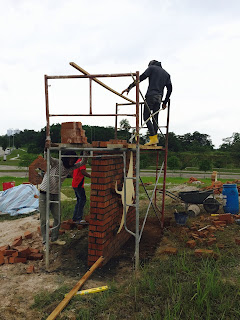我記得第一次來Iskandar 是帶著一家大小去LegoLand游玩。那時候Iskandar路上都是正在施工的建築物,一望無際被鏟平的油棕園,鏟土機的神手正在進行它大展鴻圖的目的。兩年後,我再次來到這地方,還是沒有太大變化,依然還是日夜施工,但唯一改變的是,我這次來的目的是要做Project。
那天,來到現場看場地,從edu city 再到珍珠港,最後來到這片medini 7的小山丘。小山丘的頂頭上有一座兒童游樂所。不知為什麼這個設施吸引著我的目光,它好像是被遺棄般,被排斥在角落。心開始對這片土地有一絲想像,但其實當時還是非常模糊,沒有頭緒。
雖然不知道我要做什麼,但直覺告訴我,我將會在這裡進行藝術的對話。
經過一系列的 Reserach 後,我獲知Sungai Pulai海馬保護計劃。這些已經消失黃金色的小小生物,它們象徵著人類未來悲劇的符號。于是很自然的,它與場地產生一種藝術性的對話關系,聯接整個柔彿的脈絡。然後通過柔佛海峽填土計劃,我找到碧佳園森林城市。我也來到現場,親眼目睹高耸入雲大樓的雄偉壯觀模型,也見識來自中國買家排山倒海的購買力。中國強大發展的催化劑正式進入我們的生活,未來我們會不會好像香港? 物漲地貴如多米诺骨牌效應? 它所帶來的影響力,不管是經濟,文化,還是環境課題上, 都象徵著一股風暴。
回到構思作品上,微弱的小生物與雄大的高樓所形成的強烈對比,我把這兩者結合在一起。于是我利用紅磚以堆疊形式代表高度經濟發展的建築物,并通過鏤空的處理手法來呈現消失的海洋生物。把我在碧佳園森林城市裡所見到雄偉壯觀的模型,再現到Medini 7的小山丘上。同時,鏤空的海洋生物與兒童游樂所正好形成另一個聯接想像,因為再過不久,這個遺棄的設施也會被拆除。最後一座又一座聳立的堆疊紅磚,在曾過另一個藝術家的綠化計劃下,漸漸變成了一個墓園地。
我希望我的作品可以為觀眾帶來警惕的訊息。
This PublikArt project is creating an awareness to the sea bed living species which are rapidly lost to development.
Especially, the dredging and reclamation in the Tebrau Straits have greatly reduced the size of the seagrass beds, many coastal mangroves have been demolish. Water quality degradation from industrial waste is giving a lot of threats to sea living species.
Therefore, the memorial monuments I built, it is to remind us to save them.































































